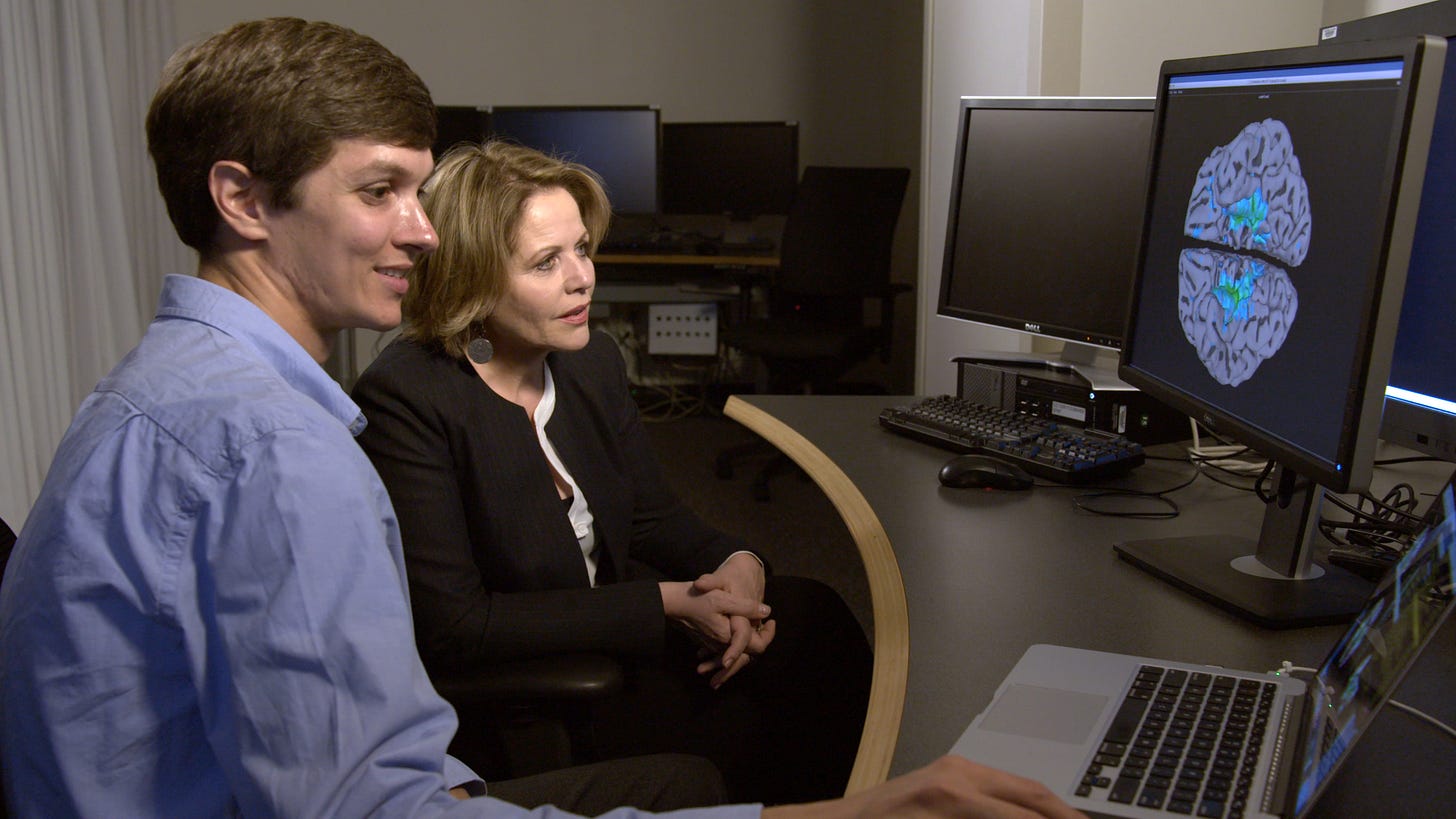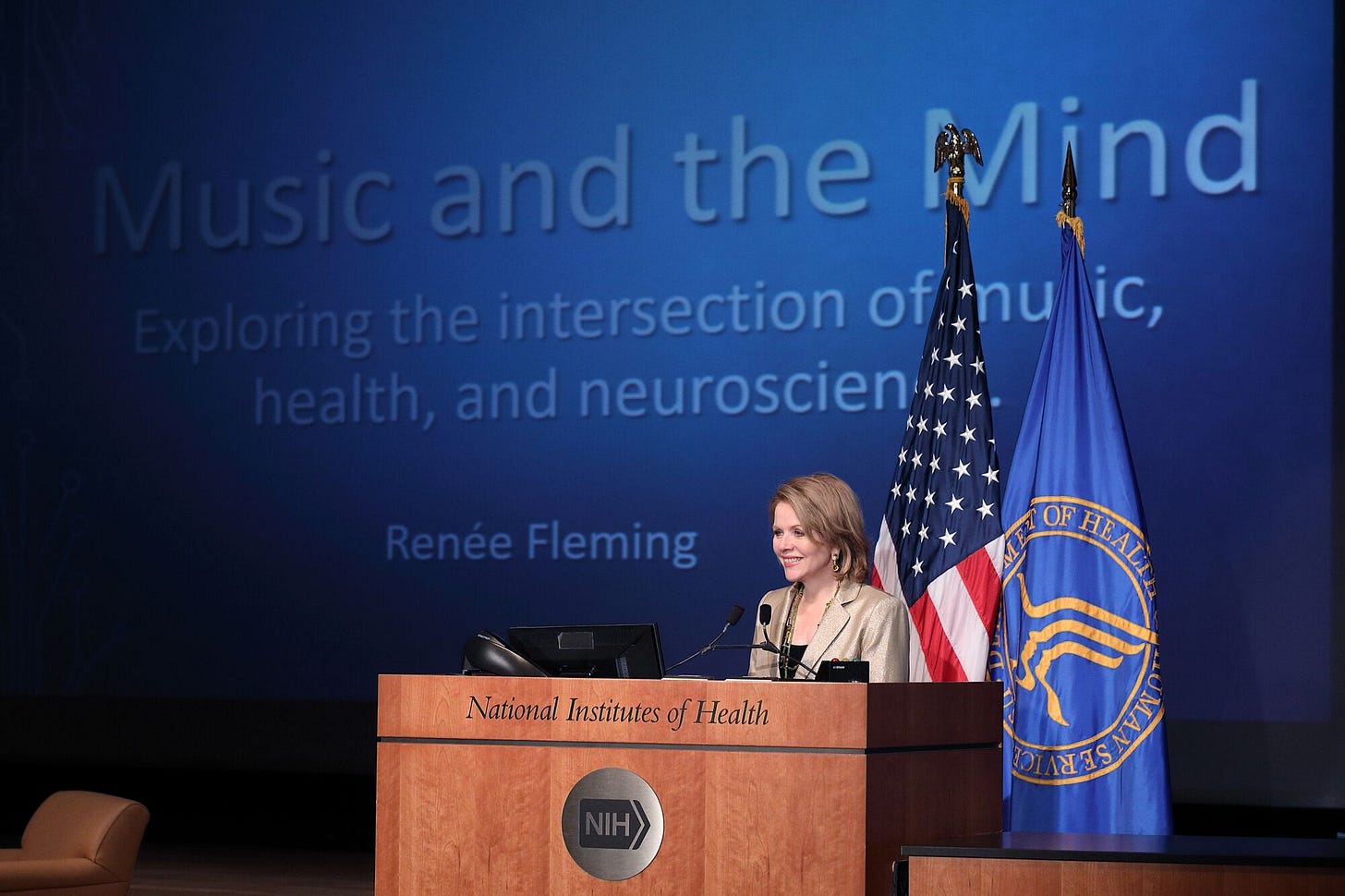"Music and Mind": An Interview with Grammy Award Winner Renée Fleming
On how neuroscientists are using music to study the brain in Renée Fleming's latest anthology.
Hello all!
Our guest this week is the supremely talented Renée Fleming. A recipient of the National Medal of Arts, Fleming has been nominated for 18 Grammy Awards and has won five times. She has sung for incredible occasions, from the Nobel Peace Prize ceremony, to the Diamond Jubilee for Queen Elizabeth II at Buckingham Palace. While best known for her work at the opera, you also probably recognize her voice more than you realize - Fleming ’s voice is featured on the soundtracks from Best Picture Oscar winners The Shape of Water and The Lord of the Rings.
Now she’s just come out with an anthology: “Music and Mind: Harnessing the Arts for Health and Wellness.” Fleming has curated a wonderful collection of essays from leading scientists, artists, creative arts therapists, educators, and healthcare providers about the powerful impacts of music and the arts on health and the human experience. It has been so fascinating to learn about the scientific side of music, and how crucial it is to form communities around the arts. I hope you enjoy!
How would you describe yourself in three words?
I would like to think of myself as curious, kind, and creative.
Did you grow up in a musical family?
Yes, both of my parents were vocal music teachers, and music was like oxygen in our home. As a toddler, I was often under the piano listening to my mother teaching voice and piano lessons. My parents say that I sang before I spoke.
What made you want to curate your anthology of essays, Music and Mind: Harnessing the Arts for Health and Wellness?
This was a passion project for me, because I realized that this incredible resource for our health, the creative arts, is not yet being utilized as it could be. Every day science reveals more about the healing power of the arts, and I wanted to bring these amazing discoveries to a general audience.
When did you first see music as a powerful tool when it comes to health?
I became fascinated when I learned that neuroscientists were using music to study the brain. I had been reading about the mind-body connection for years, ever since my own experience of somatic pain triggered by performance anxiety. When I happened to meet Dr. Francis Collins, then director of the National Institutes of Health, I asked him why scientists were looking at music. He explained that music activates more of the brain than almost any other activity. As a result, we started an initiative with the Kennedy Center, the NIH, and the NEA. That’s when the spark was really ignited for me.
What has been your biggest motivator to advocate for health and wellness?
I think everyone wants to support better health and wellness. But when I discovered that the art form I have dedicated my life to has enormous potential to improve this aspect of our lives, I became an advocate.
When do you feel the power and presence of music most strongly?
When I am onstage, and in a flow state. Performing certain pieces, I actually feel my heart rate and breathing slow down.
How did you start to learn about the impact of music on treating chronic pain? What did it teach you?
This was one of the most surprising discoveries, when I learned that music can be used to help relieve both chronic and acute pain. A friend of mine recently suffered a brain bleed and was stricken with debilitating headaches. She couldn’t look at screens, or even turn on the lights. She told me that the only thing that relieved her debilitating headaches was to listen to Jimi Hendrix at the highest possible volume.
Joke Bradt, a leading researcher on chronic pain and music, writes how music is more than just a distraction from pain; it also has long-lasting effects on the brain. Can you expand on how this works?
We know that music can help release naturally occurring pain relievers like endorphins and the hormone oxytocin. Dr. Bradt also found that vocal music therapy and active music-making can increase self-management, motivation and empowerment and reduce isolation.
You also write about how one important benefit of arts therapies, beyond targeted interventions, is the opportunity for forming crucial social connections and communities. How can we all practice and implement this more?
The simplest way, outside of specific therapy interventions, is to attend more live performances, join in group music activities like choirs, or groups around aesthetic interests, like museum visits, nature walks, even book clubs. Scientists have just discovered that, at musical performances, audience members’ brain waves actually align.
This makes perfect sense, because we are wired for art. In looking at human evolution, we know that music was an important tool for social cohesion, which was crucial for survival. In my book, there is a chapter about this evolutionary aspect of art, as well a chapter on specific cardiac benefits of choral singing. A recent discovery showed that singing in a choir greatly reduced symptoms of post-partum depression.
Ann Patchett, one of my favorite writers of all time, is included in this anthology, and I love that you also commissioned an opera of her novel, Bel Canto. She writes how “music, if we are in the habit of listening, can be the bright silver thread that stitches our lives together and makes them whole.” How can we learn to listen more closely?
With so much competing for our attention, and our phones and screens constantly in front of us, it’s important to take time to turn off the newsfeed, and really just listen to music, or look at art, or walk in a park, without those other distractions. I am making a dedicated effort to do this every day, and I’m much happier for it.
It’s interesting that in Bel Canto, Ann explores the power of music to create concord, and almost a utopian community, among people isolated from ordinary life during a hostage crisis. There’s new annotated version of the novel coming soon, and we’re working to create a playlist of the music in the book, so stay tuned.
You also are behind the partnership between the John F. Kennedy Center for the Performing Arts and the National Institutes of Health (NIH) to create Sound Health, which aims to explore the impact of music on health, science, and education, and how the brain processes music. It uniquely brings musicians and scientists together to present and demonstrate research results during an annual two-day event at the Kennedy Center. How did this partnership come about?
We launched the initiative after I met Dr. Collins. I had just been tapped to be Artistic Advisor-at-Large at the Kennedy Center, and I suggested to him that the Kennedy Center would be an ideal platform to bring this work to a broader public. The NEA came on board, and we had our first workshop at the NIH in January of 2017, followed by a major convening at the Kennedy Center in June. We recently had a follow-up in December of 2023, and the material from these convenings is on the NIH website.
What is the most surprising piece of information you’ve learned at this event?
Probably the most arresting discovery for me was learning about melodic intonation therapy, which involves using singing to regain speech lost as the result of brain trauma or stroke. The neuroplasticity of the brain allows patients, guided by therapists, to re-route and regain the function of speech by using the neural pathways of singing, which are in different parts of the brain.
I love that you are advocating for the arts to be more embedded in our healthcare system. When I was going into eye surgery, music helped immensely to calm me beforehand. Afterwards, when I couldn’t see after my surgeries, I turned to painting. How do you think we can get medical professionals to listen and refer more patients to creative arts therapists when it is often so quickly dismissed?
Ultimately, the economic argument will be most compelling, because the bottom line is so important for healthcare providers and insurers. As an example, a study done by KPMG showed that having the arts in elder care, particularly in facilities with Alzheimer’s patients, gives a three-to-one return on investment. We need to get the word out that creative arts therapy is low-cost, non-invasive, and non-pharmaceutical.
Where can readers come see you for your book tour?
I’ll be doing appearances and talks to promote the book, including the Music and Mind presentations I was already doing with local researchers and arts organizations, wherever my performing takes me.
What do you hope readers come away with after reading your book?
I wanted the book to be comprehensive, and to offer readers something from any area of this field that might pique their interest. So, it’s a hefty volume, but I want everyone to know it doesn’t have to be read cover-to-cover. There are essays by musicians like Rosanne Cash and Yo-Yo Ma, and writers like Ann Patchett, as you mentioned, and Richard Powers. And there are offerings from music therapists, neuroscientists, and arts and health thought leaders. There’s even a chapter by architect Liz Diller, who worked on the High Line and the renovation of Lincoln Center in Manhattan, about the ways architecture contributes to our health.
If someone wants to know about how the arts are used to help people with Alzheimer’s or Parkinson’s, there are chapters about those topics. My goal is really to amplify what we’ve learned so far, because the discoveries are so exciting, and it’s crucial that research keeps expanding. I believe we’re not only creating a field, but a movement, and that someday the arts will be embedded in health care.
What have been some Tiny Joys lately? (This can be anything simple, from going on walks with friends to watching old movies)
At the moment, I would say hiking. If you’re a busy person, it’s too easy not to make time for aesthetic experiences, and just to work non-stop. I am co-directing the opera and vocal music program at the Aspen Music Festival and School, and the schedule there is packed. But I have set aside time almost every morning for a hike, because it’s such a magnificent setting, and it absolutely brings me joy.
In the comments…
How has music helped you with your own healing?
How would you like to see the arts be more embraced in your healthcare system?
When do you feel the power and presence of music most strongly?











